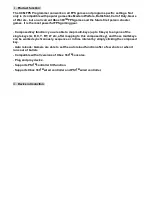
2 (4)
Uppgjord (även faktaansvarig om annan) -
Prepared (also subject responsible if other)
Nr -
No.
SES/KTR Mats Andersson
KTR97:2444
Dokansv/Godk -
Doc respons/Approved
Kontr -
Checked
Datum -
Date
Rev
File
KTR M. Andersson
1997-11-15
A
97-2444-LPC 102 213 F800 TEST HANDSET.doc
2
CONNECTIONS
Connection Type
Comment
RX line
AF output 600
, Nominal level -10 dBm
TX line
AF input
600
, Nominal level -10 dBm
The above listed connectors are located on the unit’s front.
The test unit is connected to the transceiver unit by connecting the DB9
connector on the spiraled cord to the transceiver’s service connector.
3
SWITCHES
Channel setting is made with the rotary dial on the test unit’s rear. The dial is
labelled 0 - 15 which corresponds to the channels of the F800. Set the
internal rotary switch on the F800 backplane to 0. If the line panel is
programmed to select channel, it should be removed.
The transmitter is keyed either by the built-in PTT switch on the unit’s side or
by the switch labelled PTT on the front.
The sliding switches on the unit’s upper edge is used to select either internal
signal sources microphone and earphone) or external signal sources (line
connectors).
Test
Test
Rx-line
Tx-line
Figure 2: Part of test handset showing line connections and sliding switches.
The table show the appropriate setting for the different signals. The unit is
seen from front.
Rx-line Test
(left most switch)
Tx-line Test
(right most switch)
Internal signals
Right
Left
External signals Left
Right
4
INDICATORS
Power on is indicated by a green LED labelled 12V. This indicates that the
transceiver provides 12VDC to the test unit.
Transmission is indicated by the LED labelled PTT. This LED is on when the
transceiver is in transmit mode.
Selected channel is shown by LED:s labelled CH1 to CH8. They represent the
binary value of the selected channel.















































